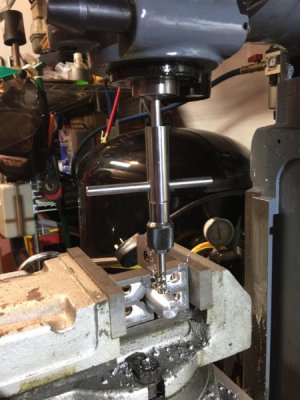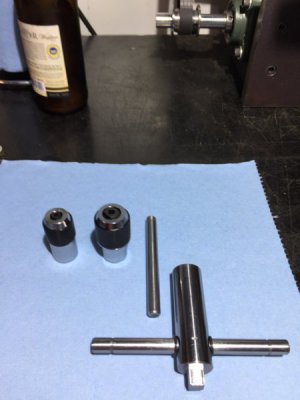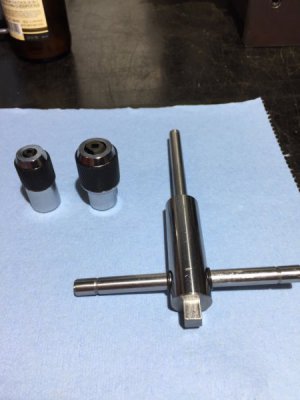- I'm a complete amateur machinist
- I've got access to basic machine tools ca 1980: no CNC or anything.
Back here https://www.hobby-machinist.com/threads/brazing-together-bronze-nuts.67149/page-2#post-562325 I was describing a piece I want to make. The first step is taking some 1 3/8 silicon bronze rod that I've got, facing and center-drilling one end, drilling a 21/32 hole about 1/2" deep or maybe a little deeper, and then facing, center drilling, and drilling a 3/4" hole from the other end to meet that one, leaving about 1/2" of 21/32. Then I'll tap the 21/32 to 3/4-10. Now I'll be able to run 3/4-10 threaded rod in from that end, and have it run through the larger hole in the remainder.
When I'm done, the piece will be about 2" long: the first half-inch threaded, about 1.5" of clearance hole. (The exact amount that's threaded doesn't matter much, as long as it's at least 0.4".)
I think I can do all that with some confidence on the lathe, although being sure not to make the clearance hole too deep will require a little care.
My problem is with tapping the 3/4-10 threads. I bought a nice fresh taper tap. I have some Tap Magic. I'd really like the tap to go in square to the hole. I see two choices:
- Grip the piece between two vee-blocks in a vise on the mill; make sure the faced bottom with the larger hole is sitting square on the bottom of the vise. Set up the tap in a really big tap-wrench. Center the table so that the quill is exactly above the center of the hole. Put something like a live-center into the quill, and use this to press gently against the tap as I take the first turn or two with the tap wrench; with each 1/4-turn or so, advance the quill a little to maintain a little pressure and be sure that I'm tapping square. Remember to ease the quill when I need to unscrew the tap wrench to break the chip. Once it's in a turn or two, forget about the quill and just keep tapping.
- Do something clever with the tailstock on the lathe, which should make the quill go exactly into the center of the piece without any further alignment of the work, etc. Turn the lathe headstock by hand to do the actual tapping (?)
Obviously, I don't actually know how to do #2, and I don't know whether it's even possibly a good idea. And it's possible that both strategies are wrong, but something else is right. I'd appreciate any suggestions. I've tapped a good deal of stuff up to about 1/4-20, with moderate success (esp. after I learned about the existence of cutting oil about 30 years ago!). But 3/4-10 just seems really intimidating, and I don't want to mess it up more than 2 or 3 times.
I'd welcome any advice before I start making chips...
--John





